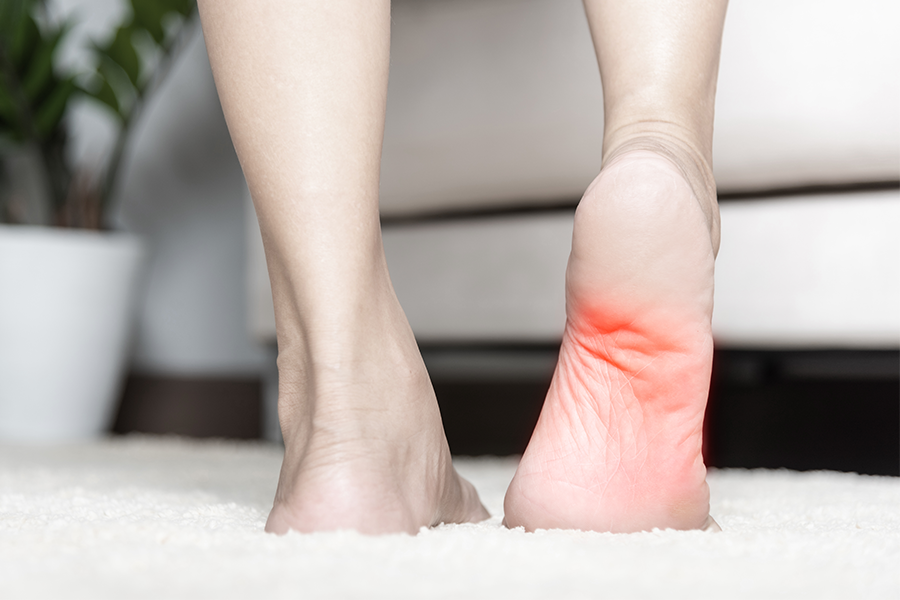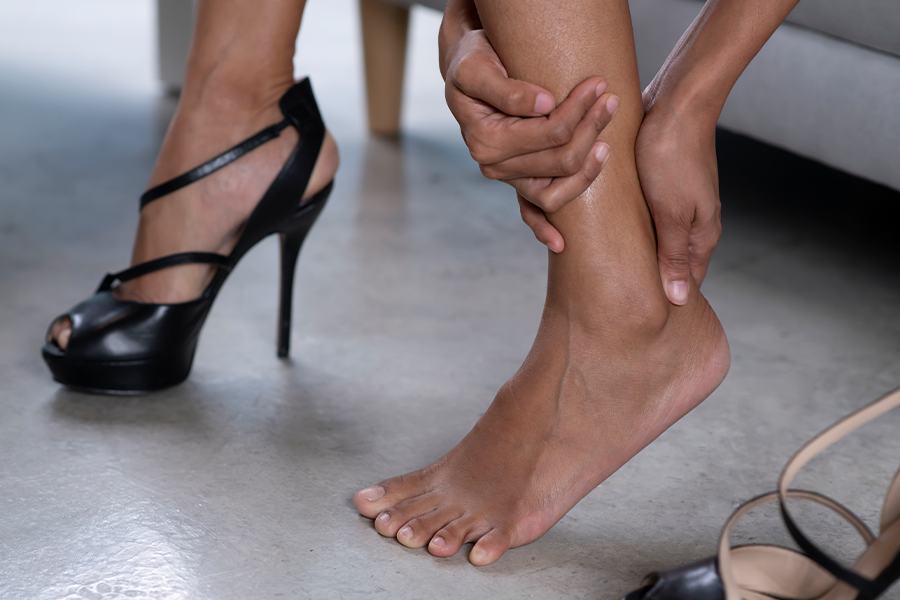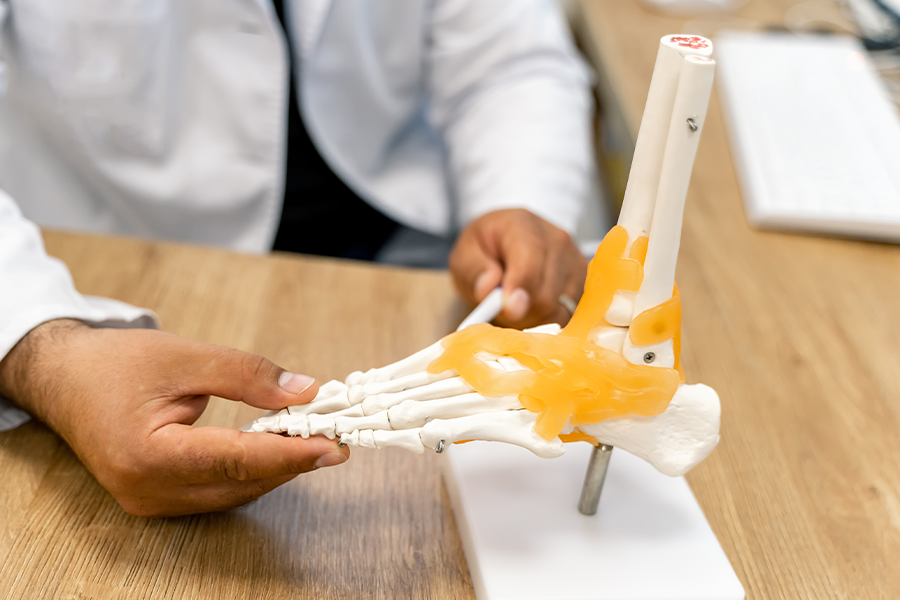- What is plantar fasciitis?
- Is foot pain always caused by plantar fasciitis?
- How is plantar fasciitis treated?
- When should I see a doctor about my plantar fasciitis?
If you have pain in the bottom of your foot, you could have plantar fasciitis. A burning, stinging sensation in your feet is the most common symptom of this type of inflammation, which flares up in more than one million Americans yearly.
Duane McRorie, D.P.M., board-certified foot and ankle surgeon and the founder of Celebration Foot and Ankle Institute, describes plantar fasciitis as “an inflammatory process in a ligament’s structure that originates in the heel and goes through the arch of the foot and into the toes.” Here’s what you need to know—and how to get help.
What Is Plantar Fasciitis?
 The plantar fascia is a thick tissue band that runs from your heel to your toes on the bottom of your foot. When that band is inflamed, you can develop the clinical condition known as plantar fasciitis. The symptoms of plantar fasciitis include stabbing, burning pain in the bottom of the affected foot. That pain is usually worse in the mornings or after sitting for a long period. As you move around, the pain may subside, but it can come back with a vengeance after running or standing for long periods.
The plantar fascia is a thick tissue band that runs from your heel to your toes on the bottom of your foot. When that band is inflamed, you can develop the clinical condition known as plantar fasciitis. The symptoms of plantar fasciitis include stabbing, burning pain in the bottom of the affected foot. That pain is usually worse in the mornings or after sitting for a long period. As you move around, the pain may subside, but it can come back with a vengeance after running or standing for long periods.
The cause of plantar fasciitis varies and, in many cases, we’re not sure why it occurs. We know that in some instances, simply being overweight can put more strain on the feet. Runners also commonly come down with plantar fasciitis or people that stand up for long periods in their job. Inside the foot, the tension and stress from these lifestyles can cause small tears in the plantar fascia that inflame and cause pain.
“Foot structure as well as shoe wear can be a cause of plantar fasciitis,” Dr. McRorie says, but also if you’re an athlete, you can overtrain your way into a painful bout of plantar fasciitis inflammation. The trick here, of course, is to know how to avoid the condition and know when to see a doctor should plantar fasciitis flare up.
Dr. McRorie says, “Plantar fasciitis can last anywhere from two weeks to a year.” The good news is that your doctor can improve the length of recovery time and get you back on your feet. What treatments will your doctor prescribe to treat plantar fasciitis?
Is Foot Pain Always Caused by Plantar Fasciitis?
 Your feet may be the most neglected part of your body. Think of the torture we put them through. You squeeze your feet into fashionable shoes, pound the pavement on a job, or perhaps spend all day standing on cement. Your feet must absorb the entire weight of your body. Wearing supportive shoes can help them carry the load, but even the best footgear can’t help sometimes with conditions such as:
Your feet may be the most neglected part of your body. Think of the torture we put them through. You squeeze your feet into fashionable shoes, pound the pavement on a job, or perhaps spend all day standing on cement. Your feet must absorb the entire weight of your body. Wearing supportive shoes can help them carry the load, but even the best footgear can’t help sometimes with conditions such as:
- Achilles tendinitis
- Arthritis
- Bone spurs
- Bunions
- Corns
- Flat feet
The foot is both tough and delicate, with 26 bones, 30 joints, and over 100 ligaments, muscles, and tendons. That’s one-fourth of all the body’s bones all crammed into a size 10-shoe. These complex structures do an amazing job of getting us where you need to go by providing balance, mobility, and support.
Most of the time, these little workhorses continue their function without complaint. Sometimes, however, you can develop a painful condition known as plantar fasciitis, and all that mobility you ask of your feet can grind to a slow and stinging halt.
How Is Plantar Fasciitis Treated?
Dr. McRorie says, “Typically we treat it (plantar fasciitis) with stretching, icing, nonsteroidal anti-inflammatories, corticosteroid injections, as well as physical therapy and inserts.”
Medications such as ibuprofen or naproxen sodium, which are commonly sold over-the-counter, may help alleviate your plantar fasciitis flare up. If this fails to help your doctor may offer:
- Custom-fitted orthotics to wear in your shoes
- Injections of a steroid directly into the plantar fascia
- Night splints to stretch the plantar fascia while you sleep
- Physical therapy treatments to stretch the plantar fascia
- Shock wave therapy to stimulate healing
- Walking boot or crutches to help protect the inflamed foot for a time
In rare cases, the doctor may recommend surgery to detach the plantar fascia from the bone of the heel. This is only when other treatments have failed and the pain is quite severe.
When Should I See a Doctor About My Plantar Fasciitis?
 You don’t have to live with foot pain, so if you’re experiencing any issues with your feet, see your doctor. The team at Celebration Foot and Ankle Institute has a variety of treatments available to help you, literally get back on your feet. Your clinical team will develop a careful treatment modality based on your lifestyle, goals, and the pain you’re experiencing.
You don’t have to live with foot pain, so if you’re experiencing any issues with your feet, see your doctor. The team at Celebration Foot and Ankle Institute has a variety of treatments available to help you, literally get back on your feet. Your clinical team will develop a careful treatment modality based on your lifestyle, goals, and the pain you’re experiencing.
You can also help prevent a flare up of plantar fasciitis by:
- Icing
- Stretching
- Not going barefooted
- Avoiding overtraining
- Wearing proper shoes
Dr. McRorie advises patients to look for a well-supportive shoe, particularly if you’re on your feet all day or engaged in sports or exercise routines that take a toll on your feet. He says you should look for a shoe that is, “Not too large or too small and that’s comfortable when you walk around.” He counsels athletes to thoroughly break in new shoes for a few weeks “before they start really running in that shoe.”
Dr. McRorie says going barefoot is a huge contributor to plantar fasciitis. He says, “That’s a huge issue with patients here in Florida. Here in Florida, we have hardwood and tile floors and everyone loves to go barefoot.” He continues, “As much as we love to do that—we shouldn’t do that because that is a common cause of plantar fasciitis.”
At Celebration Foot and Ankle Institute, our providers specialize in the delicate, tough structures that support you every day, but that you might take for granted. You don’t have to live with foot pain. Contact us for treatment today.


